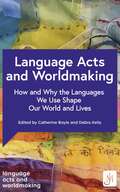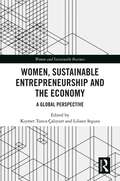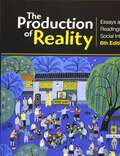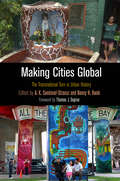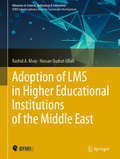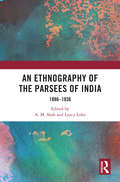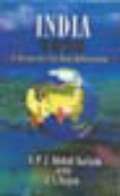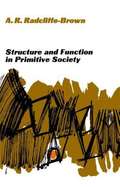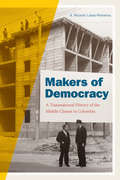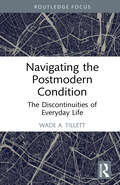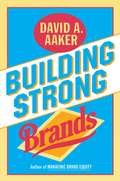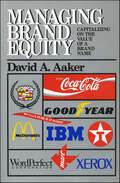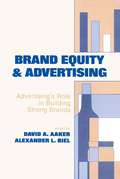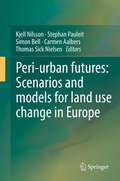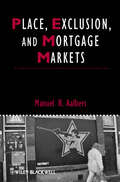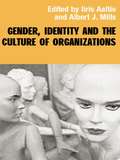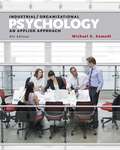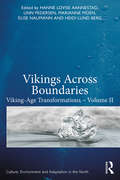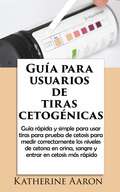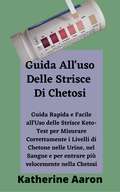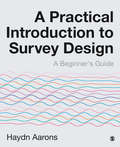- Table View
- List View
Language Acts and Worldmaking: How and Why the Languages We Use Shape Our World and Our Lives
byCollectively authored by the Language Acts and Worldmaking team, this defining volume offers reflective narratives on research, theory and practice over the course of the flagship project of the same name, funded by the Arts and Humanities Research Council's Open World Research Initiative. It returns to the project's key principles - that our words make worlds and we are agents in worldmaking - analyses the practices and outcomes of collaborative working, and looks to the future by offering concrete ideas for how the work they have done can now continue to do its work in the world.Focusing on the key research strands, this volume looks at the role of the language teacher as a mediator between languages and cultures, worldmaking in modern languages, translation and the imagination, languages and hospitality, digital mediations, and how words change and make worlds. Critically, it analyses the impact on communities of living in multilingual cities, and the ways in which learning a first language, and then a second, and so on, plays a crucial role in our ability to understand our culture in relation to others and to appreciate the ways in which they are intertwined.Specific aims are to: · propose new ways of bridging the gaps between those who teach and research languages and those who learn and use them in everyday contexts from the professional to the personal · put research into the hands of wider audiences · share a philosophy, policy and practice of language teaching and learning which turns research into action · provide the research, experience and data to enable informed debates on current issues and attitudes in language learning, teaching and research · share knowledge across and within all levels and experiences of language learning and teaching · showcase exciting new work that derives from different types of community activity and is of practical relevance to its audiences · disseminate new research in languages that engages with diverse communities of language practitioners.
Language Acts and Worldmaking: How and Why the Languages We Use Shape Our World and Our Lives
byCollectively authored by the Language Acts and Worldmaking team, this defining volume offers reflective narratives on research, theory and practice over the course of the flagship project of the same name, funded by the Arts and Humanities Research Council's Open World Research Initiative. It returns to the project's key principles - that our words make worlds and we are agents in worldmaking - analyses the practices and outcomes of collaborative working, and looks to the future by offering concrete ideas for how the work they have done can now continue to do its work in the world.Focusing on the key research strands, this volume looks at the role of the language teacher as a mediator between languages and cultures, worldmaking in modern languages, translation and the imagination, languages and hospitality, digital mediations, and how words change and make worlds. Critically, it analyses the impact on communities of living in multilingual cities, and the ways in which learning a first language, and then a second, and so on, plays a crucial role in our ability to understand our culture in relation to others and to appreciate the ways in which they are intertwined.Specific aims are to: · propose new ways of bridging the gaps between those who teach and research languages and those who learn and use them in everyday contexts from the professional to the personal · put research into the hands of wider audiences · share a philosophy, policy and practice of language teaching and learning which turns research into action · provide the research, experience and data to enable informed debates on current issues and attitudes in language learning, teaching and research · share knowledge across and within all levels and experiences of language learning and teaching · showcase exciting new work that derives from different types of community activity and is of practical relevance to its audiences · disseminate new research in languages that engages with diverse communities of language practitioners.
Women, Sustainable Entrepreneurship and the Economy: A Global Perspective (Women and Sustainable Business)
by K 305 ymet Tunca Çalı Yurt Liliane SeguraWhen a woman decides to become an ‘entrepreneur,’ she starts her business with a sense of excitement, freedom, wealth, happiness, prestige; however, these feelings can soon turn to fears over debt, difficulties, unpaid invoices, stress, and uncertainty. Being an entrepreneur means taking risks, making decisions, adapting management styles in line with developmental needs, clashing with rivals, being more agile than competitors, negotiating risky scenarios, following business trends, capturing new opportunities before, and being better than the competition. If a woman wants to be successful as an entrepreneur, she needs to have a business education, undergo continued professional development, and have patience and emotional intelligence. Supporting women in their entrepreneurial activities has been shown to positively affect the economy, which is why governments pay special attention to opening new funding opportunities and training programs for women who want to start or develop a business. Female entrepreneurship has individual characteristics because of those aspects of the business which are affected by cultural, technological, legislative, social, and historical developments. This book discusses the relationship between female entrepreneurship and the economy, and academic authors from developing countries such as Brazil, Turkey, Albania, Kosovo, Portugal, and Malaysia analyze the developments encompassing women and entrepreneurship in their respective countries. The authors discuss the regulatory frameworks of each country to show how these either help or hinder female entrepreneurship, and consequently, the place of women in the economy. Women and entrepreneurship is an emerging theme, and this book is a must-read for researchers from both developing and developed countries.
The Production of Reality: Essays and Readings on Social Interaction
by Jodi O 8242 BrienA one-of-a-kind social psychology book that inspires readers to be awake in the world. In this new, Sixth Edition, Jodi O’Brien continues to explore the historical development of the concept of the self, and help readers see the patterns we use to make sense of our own lives. The book introduces the major theories, concepts, and perspectives of contemporary social psychology in a uniquely engaging manner. Compelling original essays that provide an overarching framework are followed by a wide-ranging set of readings. By grounding social psychology in student experiences and explaining theories through stories and narratives, this one-of-a-kind book helps students understand the forces that shape their feelings, thoughts, and actions. Contributor to the SAGE Teaching Innovations & Professional Development Award Find out more at www.sagepub.com/sociologyaward
Making Cities Global: The Transnational Turn in Urban History
by A. K. Sandoval-Strausz Nancy H. Kwak Thomas J. SugrueIn recent decades, hundreds of millions of people across the world have moved from rural areas to metropolitan regions, some of them crossing national borders on the way. While urbanization and globalization are proceeding with an intensity that seems unprecedented, these are only the most recent iterations of long-term transformations—cities have for centuries served as vital points of contact between different peoples, economies, and cultures. Making Cities Global explores the intertwined development of urbanization and globalization using a historical approach that demonstrates the many forms transnationalism has taken, each shaped by the circumstances of a particular time and place. It also emphasizes that globalization has not been persistent or automatic—many people have been as likely to resist or reject outside connections as to establish or embrace them.The essays in the collection revolve around three foundational themes. The first is an emphasis on connections among the United States, East and Southeast Asia, Latin America, and South Asia. Second, contributors ground their studies of globalization in the built environments and everyday interactions of the city, because even world-spanning practices must be understood as people experience them in their neighborhoods, workplaces, stores, and streets. Last is a fundamental concern with the role powerful empires and nation-states play in the emergence of globalizing and urbanizing processes.Making Cities Global argues that combining urban history with a transnational approach leads to a richer understanding of our increasingly interconnected world. In order to achieve prosperity, peace, and sustainability in metropolitan areas in the present and into the future, we must understand their historical origins and development.Contributors: Erica Allen-Kim, Leandro Benmergui, Matt Garcia, Richard Harris, Carola Hein, Nancy Kwak, Carl Nightingale, Amy C. Offner, Margaret O'Mara, Nikhil Rao, A. K. Sandoval-Strausz, Arijit Sen, Thomas J. Sugrue.
Adoption of LMS in Higher Educational Institutions of the Middle East (Advances in Science, Technology & Innovation)
by Rashid A. Khan Hassan Qudrat-UllahThis book discusses the adoption of learning management systems (LMS) in higher education institutions. It presents influential predictors that may impact instructors’ behavioral intention to adopt learning management systems in the context of Arab culture, as well as a unique model of technology acceptance that draws on and combines previous technology adoption models (i.e., a modified unified theory of acceptance and use of technology model – UTAUT2). Moreover, this study extends the UTAUT2 model by including Hofstede’s (1980) cultural dimensions, and technology awareness as the moderators of the model. It also describes the explanatory technique approach used to collect quantitative data from the instructors at higher education institutions in Saudi Arabia and were analyzed with structural equation modeling using SPSS/Amos software. The findings revealed that facilitating conditions were the strongest predictor of behavioral intention to adopt an LMS, followed by performance expectancy and hedonic motivation, technology awareness, and cultural dimensions exerted a moderating influence on instructors’ behavioral intention to use LMS in their teaching. By including new constructs, this becomes the first study of its kind exploring instructors’ use of LMS in Higher Educational Institutions of Saudi Arabia and other countries of the Middle East. It offers practical insights for a broad range of researchers and professionals at higher education institutions and serves as a reference guide for designers of learning management systems (e.g., blackboard systems), policymakers, and the Ministry of Education staff.
An Ethnography of the Parsees of India: 1886–1936
by A. M. Shah and Lancy LoboThis volume explores a wide spectrum of Parsee culture and society derived through essays from the Journal of Anthropological Society of Bombay (1886–1936). This journal documents intensive scholarship on the Parsee community by eminent anthropologists, Indologists, orientalogists, historians, linguists, and administrators in the late 18th and early 19th centuries. Comprising 0.05% of India’s total population today, the Parsees (now spelled “Parsis”) have made significant contributions to modern India. Through contributions of Jivanji Jamshedji Modi, Bomanjee Byramjee Patell, and Rustamji Munshi, eminent Parsee scholars, the essays in this book discuss the social and cultural frameworks which constitute various key phases in the Parsee life nearly 100 years ago. They also focus on themes such as birth, childhood and initiation, marriage, and death. The volume also features works on Parsee folklore and oral literature. An important contribution to Parsi culture and living, this book will be of great interest to scholars and researchers of sociology, social anthropology, ethnography, cultural studies, history, and South Asia studies.
INDIA 2020 - A Vision for the New Millennium
by A. P. J Abdul Kalam Y S RajanIn this ground-breaking vision document Abdul Kalam and Y.S. Rajan offer a blueprint for India to be counted among the world's top five economic powers by the year 2020. They cite growth rates and development trends to show that the goal is not unrealistic.
Structure And Function In Primitive Society:Essays and Addresses
by A. R. Radcliffe-BrownThis book shows the development of the thought of a distinguished anthropologist for the last twenty-five years, and at the same time illustrate some of the more important changes in the orientation of social anthropology, with which Professor Radcliffe-Brown was so intimately associated during this period. These essays have also demonstrated their value in the training of graduate students in major centres for social anthropology.
Makers of Democracy: A Transnational History of the Middle Classes in Colombia (Radical Perspectives)
by A. Ricardo López-PedrerosIn Makers of Democracy A. Ricardo López-Pedreros traces the ways in which a thriving middle class was understood to be a foundational marker of democracy in Colombia during the second half of the twentieth century. Drawing on a wide array of sources ranging from training manuals and oral histories to school and business archives, López-Pedreros shows how the Colombian middle class created a model of democracy based on free-market ideologies, private property rights, material inequality, and an emphasis on a masculine work culture. This model, which naturalized class and gender hierarchies, provided the groundwork for Colombia's later adoption of neoliberalism and inspired the emergence of alternate models of democracy and social hierarchies in the 1960s and 1970s that helped foment political radicalization. By highlighting the contested relationships between class, gender, economics, and politics, López-Pedreros theorizes democracy as a historically unstable practice that exacerbated multiple forms of domination, thereby prompting a rethinking of the formation of democracies throughout the Americas.
Navigating the Postmodern Condition: The Discontinuities of Everyday Life
by Wade A. TillettDrawing on poststructuralist frameworks, this book examines the way to a radical acceptance of daily discontinuities and difference as it allows us to embrace life in the postmodern world.With each chapter exploring the human relationship with a disjunction in daily life, such as sleeping, forgetting, and multitasking, the author examines overlooked aspects of daily living as fresh data from which to analyze our condition. A phenomenological study of postmodern life, the book provides anecdotes of what it is like to live through these gaps and theorizes how we use these gaps. Using an arts-based methodology, the author also allows the work to mirror the discontinuities which it describes, interrupting the assumption of our lives as continuous and unitary in both form and content. Addressing the vast jumble of contradictions that is our daily experience in this contemporary world, it offers explanation through theory and anecdote and illustrates the path toward radical acceptance, which allows us to see ourselves as beautifully composed of fractures, gaps, and overflow. It will appeal to scholars, researchers, and postgraduate students with interests in poststructuralism, curriculum theory, and art-based research methods.
Building Strong Brands
by David A. AakerAs industries turn increasingly hostile, it is clear that strong brand-building skills are needed to survive and prosper. In David Aaker's pathbreaking book, Managing Brand Equity, managers discovered the value of a brand as a strategic asset and a company's primary source of competitive advantage. Now, in this compelling new work, Aaker uses real brand-building cases from Saturn, General Electric, Kodak, Healthy Choice, McDonald's, and others to demonstrate how strong brands have been created and managed.A common pitfall of brand strategists is to focus on brand attributes. Aaker shows how to break out of the box by considering emotional and self-expressive benefits and by introducing the brand-as-person, brand-as-organization, and brand-as-symbol perspectives. The twin concepts of brand identity (the brand image that brand strategists aspire to create or maintain) and brand position (that part of the brand identity that is to be actively communicated) play a key role in managing the "out-of-the-box" brand.A second pitfall is to ignore the fact that individual brands are part of a larger system consisting of many intertwined and overlapping brands and subbrands. Aaker shows how to manage the "brand system" to achieve clarity and synergy, to adapt to a changing environment, and to leverage brand assets into new markets and products.Aaker also addresses practical management issues, introducing a set of brand equity measures, termed the brand equity ten, to help those who measure and track brand equity across products and markets. He presents and analyzes brand-nurturing organizational forms that are responsive to the challenges of coordinated brands across markets, products, roles, and contexts. Potentially destructive organizational pressures to change a brand's identity and position are also discussed.As executives in a wide range of industries seek to prevent their products and services from becoming commodities, they are recommitting themselves to brands as a foundation of business strategy. This new work will be essential reading for the battle-ready.
Building Strong Brands
by David A. AakerAs industries turn increasingly hostile, it is clear that strong brand-building skills are needed to survive and prosper. In David Aaker's pathbreaking book, Managing Brand Equity, managers discovered the value of a brand as a strategic asset and a company's primary source of competitive advantage. Now, in this compelling new work, Aaker uses real brand-building cases from Saturn, General Electric, Kodak, Healthy Choice, McDonald's, and others to demonstrate how strong brands have been created and managed. A common pitfall of brand strategists is to focus on brand attributes. Aaker shows how to break out of the box by considering emotional and self-expressive benefits and by introducing the brand-as-person, brand-as-organization, and brand-as-symbol perspectives. The twin concepts of brand identity (the brand image that brand strategists aspire to create or maintain) and brand position (that part of the brand identity that is to be actively communicated) play a key role in managing the "out-of-the-box" brand. A second pitfall is to ignore the fact that individual brands are part of a larger system consisting of many intertwined and overlapping brands and subbrands. Aaker shows how to manage the "brand system" to achieve clarity and synergy, to adapt to a changing environment, and to leverage brand assets into new markets and products. Aaker also addresses practical management issues, introducing a set of brand equity measures, termed the brand equity ten, to help those who measure and track brand equity across products and markets. He presents and analyzes brand-nurturing organizational forms that are responsive to the challenges of coordinated brands across markets, products, roles, and contexts. Potentially destructive organizational pressures to change a brand's identity and position are also discussed. As executives in a wide range of industries seek to prevent their products and services from becoming commodities, they are recommitting themselves to brands as a foundation of business strategy. This new work will be essential reading for the battle-ready.
Managing Brand Equity: Capitalizing on the Value of a Brand Name
by David A. AakerThe most important assets of any business are intangible: its company name, brands, symbols, and slogans, and their underlying associations, perceived quality, name awareness, customer base, and proprietary resources such as patents, trademarks, and channel relationships. These assets, which comprise brand equity, are a primary source of competitive advantage and future earnings, contends David Aaker, a national authority on branding. Yet, research shows that managers cannot identify with confidence their brand associations, levels of consumer awareness, or degree of customer loyalty. Moreover in the last decade, managers desperate for short-term financial results have often unwittingly damaged their brands through price promotions and unwise brand extensions, causing irreversible deterioration of the value of the brand name. Although several companies, such as Canada Dry and Colgate-Palmolive, have recently created an equity management position to be guardian of the value of brand names, far too few managers, Aaker concludes, really understand the concept of brand equity and how it must be implemented. In a fascinating and insightful examination of the phenomenon of brand equity, Aaker provides a clear and well-defined structure of the relationship between a brand and its symbol and slogan, as well as each of the five underlying assets, which will clarify for managers exactly how brand equity does contribute value. The author opens each chapter with a historical analysis of either the success or failure of a particular company's attempt at building brand equity: the fascinating Ivory soap story; the transformation of Datsun to Nissan; the decline of Schlitz beer; the making of the Ford Taurus; and others. Finally, citing examples from many other companies, Aaker shows how to avoid the temptation to place short-term performance before the health of the brand and, instead, to manage brands strategically by creating, developing, and exploiting each of the five assets in turn
Brand Equity & Advertising: Advertising's Role in Building Strong Brands (Advertising And Consumer Psychology Ser.)
by David A. Aaker Alexander L. BielThe tenth annual Advertising and Consumer Psychology Conference held in San Francisco focused on branding -- a subject generating intense interest both in academia and in the "real world." The principle theory behind these conferences is that much can be gained by joining advertising and marketing professionals with academic researchers in advertising. Professionals can gain insight into the new theories, measurement tools and empirical findings that are emerging, while academics are stimulated by the insights and experience that professionals describe and the research questions that they pose. This book consists of papers delivered by experts from academia and industry discussing issues regarding the role of advertising in the establishment and maintenance of brand equity -- making this volume of interest to advertising and marketing specialists, as well as consumer and social psychologists.
Peri-urban futures: Scenarios and models for land use change in Europe
by Carmen Aalbers Kjell Nilsson Simon Bell Stephan Pauleit Thomas A. Sick NielsenPresently, peri-urbanisation is one of the most pervasive processes of land use change in Europe with strong impacts on both the environment and quality of life. It is a matter of great urgency to determine strategies and tools in support of sustainable development. The book synthesizes the results of PLUREL, a large European Commission funded research project (2007-2010). Tools and strategies of PLUREL address main challenges of managing land use in peri-urban areas. These results are presented and illustrated by means of 7 case studies which are at the core of the book. This volume presents a novel, future oriented approach to the planning and management of peri-urban areas with a main focus on scenarios and sustainability impact analysis. The research is unique in that it focuses on the future by linking quantitative scenario modeling and sustainability impact analysis with qualitative and in-depth analysis of regional strategies, as well as including a study at European level with case study work also involving a Chinese case study.
Place, Exclusion and Mortgage Markets (IJURR Studies in Urban and Social Change Book Series #37)
by Manuel B. AalbersUtilizing research from the U.S., Italy, and the Netherlands, Place, Exclusion and Mortgage Markets presents an in depth examination of the practice of redlining and the broader implications of contemporary urban exclusion processes. Covers exclusion in mortgage markets in three different countries - the U.S., Italy, and the Netherlands Presents an interdisciplinary perspective to the practice of redlining Connects the literature on social exclusion and financial exclusion
Gender, Identity and the Culture of Organizations (Routledge Studies in Management, Organizations and Society)
by Iiris Aaltio Albert J. MillsGender, Identity and the Culture of Organizations considers how organizations operate as spaces in which minds are gendered and men and women constructed. This edited collection brings together four powerful themes that have developed within the field of organizational analysis over the past two decades: organizational culture; the gendering of organizations; post-modernism and organizational analysis; and critical approaches to management. A range of essays by distinguished writers from countries including the UK, USA, Canada, Denmark, Sweden, Finland, the Netherlands and Sweden, explore innovative methods for the critical theorizing of organizational cultures.In particular, the book reflects the growing interest in the impact of organizational identity formation and its implications for individuals and organizational outcomes in terms of gender. The book also introduces research designs, methods and methodologies by which can be used to explore the complex interrelationships between gender, identity and the culture of organizations.
Industrial/Organizational Psychology: An Applied Approach
by Michael G. AamodtStriking a balance between research, theory, and application, the eighth edition of INDUSTRIAL/ORGANIZATIONAL PSYCHOLOGY: AN APPLIED APPROACH helps readers discover the relevance of industrial/organizational psychology in everyday life through practical application. Readers analyze topics such as resume writing, interview survival, job description authoring, performance appraisal, employment law, job satisfaction, work motivation, and leadership. Humor, case studies, real-world examples, and a friendly writing style make the book both readable and interesting. Numerous charts, tables, flowcharts, and exercises help readers conceptualize complex issues.
Vikings Across Boundaries: Viking-Age Transformations – Volume II (Culture, Environment and Adaptation in the North)
by Hanne Lovise AannestadThis volume explores the changes that occurred during the Viking Age, as Scandinavian societies fell in line with the larger forces that dominated the Insular world and Continental Europe, absorbing the powerful symbiosis of Christianity and monarchy, adapting to the idea of royal lineage and supremacy, and developing a buzzing urbanism coupled with large-scale trade networks. Presenting research on the grand context of the Viking Age alongside localised studies, it contributes to the furthering of collaborations between local and ‘outsider’ research on the Viking Age. Through a diversity of approaches on the Viking homelands and the wider world of the Vikings, it offers studies of a range of phenomena, including urban and rural settlements; continuity in the use of places as well as new types of places specific to the Viking Age; the social significance of change; the construction and maintenance of social identity both within the ‘homelands’ and across large territories; ethnicity; and ideas of identity and the creation and recreation of identity both at home and abroad. As such, it will appeal to historians and archaeologists with interests in Viking-Age studies, as well as scholars of Scandinavian studies.
Guia Para Usuário De Fitas De Teste De Cetose
by Katherine AaronGuia rápido e fácil de como usar as fitas de teste para medir corretamente os níveis de cetona na urina, no sangue, e entrar em cetose mais rapidamente.
Guía para usuarios de tiras cetogénicas: Guía rápida para usar tiras cetogénicas, medir niveles de cetona y entrar en cetosis más rápido
by Katherine Aaron¡La guía completa sobre cómo medir los niveles de cetonas en la orina, la sangre y cómo entrar en cetosis más rápido! ¿No está muy seguro si se encuentra en cetosis? ¿Pero tiene fatiga, sed, gripe y mal aliento? ¡Ha seguido una dieta cetogénica durante algunos días! ¿Está buscando una guía completa sobre cómo usar las tiras de prueba de cetosis y las formas de entrar en cetosis más rápido en 48 horas? Si esto es lo que estás experimentando, ¡siga leyendo! Las tiras cetogénicas o las tiras de prueba de cetona son papeles distintivos finamente cortados en los que orina o deja caer sangre y cambiará de color en caso de orina y proporcionará datos en caso de sangre para mostrar los niveles de cetona en el sistema. Estas tiras no solo verifican las cetonas en el cuerpo, sino que también nos ayudarán a informarnos cuando estamos obteniendo demasiadas cetonas que pueden conducir a cetoacidosis (una afección en la que la sangre se vuelve ácida). Estas tiras fueron creadas inicialmente para controlar afecciones médicas como diabetes tipo II, cáncer y epilepsia. Todas estas condiciones pueden ser controladas si las cetonas en el cuerpo están bien mantenidas. Esta guía “GUÍA DEL USUARIO DE TIRAS DE CETOSIS: Guía rápida y fácil de usar tiras de prueba de ceto para medir correctamente los niveles de cetonas en orina, sangre y entrar en cetosis más rápido” brindará información sobre lo siguiente: Cómo entrar en cetosis Entrar en cetosis ¿Por qué la necesidad de cetosis? Afirmar que se encuentra en cetosis Cómo lidiar con los síntomas incómodos causados por la cetosis Cómo entrar en cetosis más rápido Como medir cetonas Cómo funcionan las tiras cetogénicas Tipos de tiras de cetogénicas ¿Son precisas las tiras cetogénicas? Cómo funcionan las tiras de análisis de cetona en sangre<br
Guida All'uso Delle Strisce Di Chetosi
by Katherine AaronLa Guida completa su come misurare i livelli di chetoni nelle urine, nel sangue e come entrare più velocemente nella chetosi! Non siete troppo sicuri di essere in chetosi? Ma avete affaticamento, sete, influenza e boccaccia? Avete fatto una dieta chetogena per alcuni giorni! Siete alla ricerca di una guida completa su come usare le strisce reattive per la chetosi e su come entrare più velocemente nella chetosi entro 48 ore? Se questo è ciò che state sperimentando, continuate a leggere! Le strisce reattive per chetogeni o le strisce reattive per chetoni sono foglietti distintivi tagliati sottili su cui si fa pipì o su cui si fa cadere il sangue e che cambiano colore in caso di urina e forniscono dati in caso di sangue per mostrare i livelli di chetoni nel sistema. Queste strisce non solo controlleranno i chetoni nell'organismo, ma ci aiuteranno anche a capire quando abbiamo troppi chetoni che possono portare alla chetoacidosi (una condizione in cui il sangue diventa acido). Queste strisce sono state inizialmente create per gestire condizioni mediche come il diabete di tipo II, il cancro e l'epilessia. Tutte queste condizioni possono essere regolate se i chetoni nel corpo sono ben mantenuti. Questa guida "GUIDA PER L'USO DELLE STRISCE KETO: Guida rapida e facile all'uso delle strisce per misurare correttamente i livelli di chetoni nelle urine, nel sangue e per entrare più velocemente nella chetosi" farà luce su quanto segue: Come entrare in chetosi Entrare in chetosi Perché la necessità della chetosi Segnatevi che siete in chetosi Come gestire i sintomi scomodi dovuti alla chetosi Come entrare più velocemente nella chetosi Come misurare i chetoni Come funzionano le strisce di keto Tipi di strisce di chetosi Le strisce di keto sono precise? Come funzionano le strisce per il test del chetone Tempo di us
A Practical Introduction to Survey Design: A Beginner′s Guide
by Haydn AaronsThis is your definitive guide to designing your social survey. It includes all the knowledge and skills you need to plan your survey with confidence and ease. Every step of survey design from developing your questions, to administering your survey and preparing your data for analysis, is explained in easy to follow language. It features: Case studies demonstrating how effective surveys are conducted in real life Clear advice on how to design an ethical social survey Practical exercises to help you construct your survey Suggestions for further reading taken from cutting edge, multidisciplinary sources The book also comes with a host of useful online resources, including templates and reflective questions, to help strengthen your understanding and apply your new found knowledge.
A Practical Introduction to Survey Design: A Beginner′s Guide
by Haydn AaronsThis is your definitive guide to designing your social survey. It includes all the knowledge and skills you need to plan your survey with confidence and ease. Every step of survey design from developing your questions, to administering your survey and preparing your data for analysis, is explained in easy to follow language. It features: Case studies demonstrating how effective surveys are conducted in real life Clear advice on how to design an ethical social survey Practical exercises to help you construct your survey Suggestions for further reading taken from cutting edge, multidisciplinary sources The book also comes with a host of useful online resources, including templates and reflective questions, to help strengthen your understanding and apply your new found knowledge.
